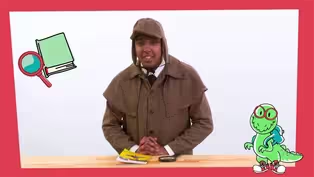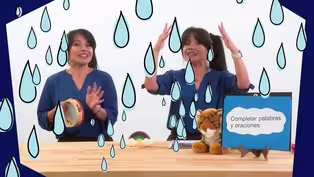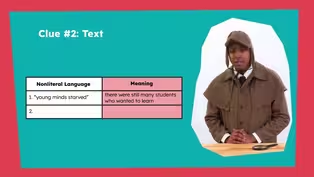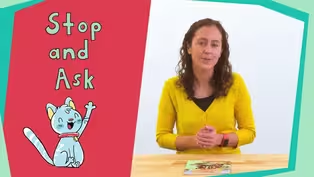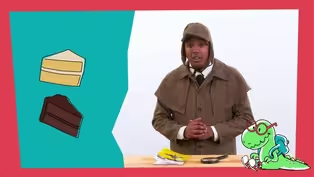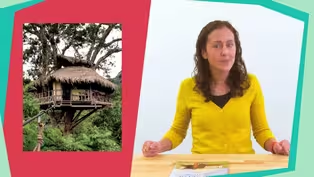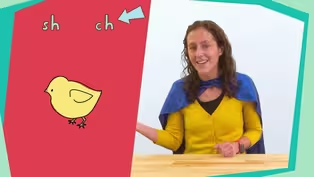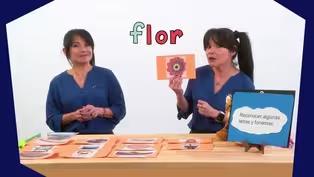
Episode 20 | Literacy Lessons
3/30/2021 | 28m 46sVideo has Closed Captions
Literacy lessons for early learners, led by NC teachers.
The first lesson (aimed at 3rd graders) helps students explore how point of view impacts narration style and character perception. The second lesson (aimed at PreK-K learners) helps students recognize letters Pp, Ii, and Gg, and their sounds. Classroom Connection is your At-Home Learning companion where children love to learn. All lessons are led by NC educators.
Problems playing video? | Closed Captioning Feedback
Problems playing video? | Closed Captioning Feedback
At-Home Learning Presents: Classroom Connection is a local public television program presented by PBS NC

Episode 20 | Literacy Lessons
3/30/2021 | 28m 46sVideo has Closed Captions
The first lesson (aimed at 3rd graders) helps students explore how point of view impacts narration style and character perception. The second lesson (aimed at PreK-K learners) helps students recognize letters Pp, Ii, and Gg, and their sounds. Classroom Connection is your At-Home Learning companion where children love to learn. All lessons are led by NC educators.
Problems playing video? | Closed Captioning Feedback
How to Watch At-Home Learning Presents: Classroom Connection
At-Home Learning Presents: Classroom Connection is available to stream on pbs.org and the free PBS App, available on iPhone, Apple TV, Android TV, Android smartphones, Amazon Fire TV, Amazon Fire Tablet, Roku, Samsung Smart TV, and Vizio.
Providing Support for PBS.org
Learn Moreabout PBS online sponsorshipMore from This Collection
Video has Closed Captions
Literacy lessons for early learners, led by NC teachers. (28m 46s)
Video has Closed Captions
Literacy lessons for early learners, led by NC teachers. (28m 46s)
Video has Closed Captions
Literacy lessons for early learners, led by NC teachers. (28m 45s)
Video has Closed Captions
Literacy lessons for early learners, led by NC teachers. (28m 45s)
Video has Closed Captions
Literacy lessons for early learners, led by NC teachers. (28m 46s)
Video has Closed Captions
Literacy lessons for early learners, led by NC teachers. (28m 46s)
Video has Closed Captions
Literacy lessons for early learners, led by NC teachers. (28m 45s)
Video has Closed Captions
Short Description: Literacy lessons for early learners, led by NC teachers. (28m 45s)
Video has Closed Captions
Literacy lessons for early learners, led by NC teachers. (28m 45s)
Video has Closed Captions
Literacy lessons for early learners, led by NC teachers. (28m 45s)
Video has Closed Captions
Literacy lessons for early learners, led by NC teachers. (28m 45s)
Video has Closed Captions
Literacy lessons for early learners, led by NC teachers. (28m 45s)
Providing Support for PBS.org
Learn Moreabout PBS online sponsorship[cheerful upbeat music] ♪ - All right, get ready for a super cool literacy lesson.
Literacy means reading and we're gonna learn all about reading sounds, words and sentences.
Did you know, without reading you wouldn't know what street you live on?
How would you even get the mail?
Well get ready 'cause we're gonna get started right now.
- Hello again, everyone.
Thank you so much for joining me, Ms. Shannon and our friend the Sun again today as we continue to explore "Sun!
One in a Billion" written by Stacy McAnulty and illustrated by Stevie Lewis.
We've talked before about how "Sun!
One in a Billion" has facts like an informational or non-fiction text but it also seems like a fiction text.
This is because it pretends the Sun is a living character with a personality and feelings even though in real life, we know the Sun is not alive.
[soft music] So it has some elements of informational nonfiction texts and some elements of fiction texts.
The author combined fiction and nonfiction genres to create this book which is a huge part of her writing style.
When we mentioned an author's style, we're talking about the way a writer writes, the decisions they make and the techniques they use to give their work a certain tone or feeling.
Different writers have different styles.
Stacy McAnulty has written many books in this same style, combining information with imagination to make them more enjoyable.
If you like this one, you should read more of her work.
She has one about the moon, one about the earth and another about the ocean.
Now we're going to think about the point of view from which this book was written, because it's a huge part of the author's writing style.
So what is point of view?
In a text, point of view is the way the one telling the story sees and explains the characters, places or events they observe.
So if we want to figure out whose point of view "Sun!
One in a Billion" is written from, we first need to ask ourselves, who's talking to us when we read this text?
Watch me look at this book and figure out whose point of view it's written from or who's talking to us when we read and tells us what's happening.
[air whooshes] I see a clue right here on the title page.
It says the book is written by Sun with Stacy McAnulty and illustrated by Sun with Stevie Lewis.
Hmm, that's strange.
I've seen that on a title page before in a book like this and I know the Sun can't actually write words and draw illustrations.
I'm going to read the first page and see if I can find more clues to help me figure out the point of view from which this text is written.
You can read with me.
Once upon a time, about 4.6 billion years ago, a magnificent and important star was born and that magnificent and important star was me.
Your Sun with a capital S. Oh, it says me.
So the character talking to us in this book just called itself me and then it tells us it's the Sun.
That's why the title page said it was by Sun because the Sun is telling the story.
The author added that detail to the title page to make that fun, imaginative part of her style even stronger and give us a clue about who will be telling the story.
So now we know that this text is written from the Sun's point of view.
That means that as we read, we're only getting the thoughts and feelings of the Sun.
We have to guess the thoughts and feelings of other characters in the text When texts are written from the perspective of a character actually in the story, it's called first person-point of view.
This is very different than another point of view which is called third-person.
In third-person point of view, the story is being told by someone not involved in it at all called a narrator.
When texts are written from third-person point of view, you'll see words like she, his and them.
Instead of ones like I and me that you'd find in a first-person point of view text.
This is because a third-person narrator isn't in the story so they're always talking about other characters not themselves.
So a quick tip when you're reading other books in the future, if you're trying to figure out which point of view a text is written from, the pronouns, words like I, me, he, she and they can give you great information.
Now that we know how first and third person point of view work, let's think a little more about how point of view affects what we learn from the text.
[air whooshes] [soft music] On this page, the Sun tells us that it's much bigger than the Moon but the Moon is much closer to earth.
So we know what the Sun is thinking about here because it tells us but we don't know what the Moon or Earth are thinking, do we?
We have no idea.
We can see that they're smiling and seem happy but we can't be sure why.
Why do you think the Moon is smiling here?
[soft music] You could be right.
I think maybe it's smiling because it loves being so close to its best buddy the Earth but we'll never know for sure because this book doesn't tell us anything from the Moon's perspective.
We simply have to guess.
We can use the pictures and text to make a good guess but it's still just a guess.
But what if this book was written from third-person point of view with a narrator not in the book at all?
Guess what?
When texts are written from an outside narrator's point of view, you can learn what multiple characters are thinking and feeling because you're not always limited to only one character's thoughts.
So let's pretend we're going to rewrite this page from a third-person narrator's point of view, what would we need to change to include both characters' feelings?
[soft music] Yes, it could say something like, the Sun thinks it's the most amazing because it's bigger than the Moon but the Moon actually doesn't care about size.
It's really happy because it's always right beside its best buddy, the Earth.
That's just the way I chose to do it.
You may have chosen something different.
With a third-person narrator, there are so many possibilities because you can get into any character's head and find out what they're thinking.
Let's do another one.
[air whooshes] [soft music] On these pages, the Sun tells us that it's the center of the solar system and we know that makes the Sun feel good about itself.
But because this book is written in first-person point of view by the Sun, we have no idea how the other characters on the page are feeling or what they're thinking.
Look at all those planets, we have to make our best guess about what's going on in their minds.
Let's focus on Saturn and Uranus.
We can see that they're smiling and giving each other a high five, but we have no idea why.
Did they just win a contest?
Are they excited about a snack?
Did one of them tell a funny joke?
Who knows?
If this book were written from one of their perspectives, we would know.
Imagine why they might be high-fiving.
I'll give you some time to think.
[soft music] What did you come up with?
I imagined that they're celebrating because they just worked together to save a star from falling out of the galaxy.
You may have imagined something different and that's okay.
Either way, if we knew their thoughts and feelings, this page would sound very different.
The Sun may not be the center of attention if we could also hear from other characters.
Now that we've thought about the different points of view of some characters in this book, let's think about how your point of view could be different from the Sun's.
Let's reread two pages.
You can read with me.
[soft music] Can you hang out for eight minutes?
That's how long it takes my light to reach earth.
Yup, I give you heat and light.
You're welcome.
I'm so important that earthlings should name a special day in my honor.
We can call it Sunday.
Oh, wait.
We can tell just from this small part of the book that the Sun thinks it is awesome and that everything about it is fabulous.
But now I want you to imagine that you're out working on this farm and it's the hottest day of the year.
It's actually the hottest day of your life.
Place yourself in these pages.
What would it be like having to work outside on the farm under the bright hot Sun?
[soft music] You're probably thinking something like, "It is so hot that hot doesn't even begin to describe it.
It's sweltering."
You're so hot that you're absolutely miserable.
You look around and the animals are also really hot.
Keep that in your mind and grab some paper and something to write with.
Jot down what the page would say if you explained this picture from your very hot and miserable perspective.
Remember that in your writing, you're the one talking about what's going on around you.
You can start with, "It is so hot I," And add on whatever you want from there.
I'll give you a quick minute to write and while you write, I will write also.
[soft music] [air whooshes] [mellow music] [mellow music continues] So what did you write?
How does this page sound from your perspective?
Let me show you mine.
It is so hot!
I feel like I'm melting.
I know the Sun is important because we need it for warmth and light but some days I really wish it would stop shining so hard and let things stay a little cooler around here.
Look at it smiling, does it not realize that it's sending us too much heat right now?
I don't even wanna be out near the Sun anymore.
I'm going inside, too bad I can't bring the animals with me.
I know they want a break from the heat too.
Of course your writing isn't exactly like mine but that's okay.
The important thing is, that you wrote it from your perspective or point of view which is different from the Sun's.
Let's look at this page from the Sun's point of view, alongside the same page from my point of view.
Are they pretty similar or pretty different?
[soft music] Yes, they're pretty different.
If people only read this page from the Sun's perspective, they wouldn't realize how hot the people and animals were.
If they only read it from my perspective, they wouldn't realize that the Sun thinks it's the most wonderful thing around.
Isn't it amazing how different a text can be depending on whose point of view it's written from?
As you read, you should always think about how a text's point of view impacts what you learned about the characters and events.
Today we learned that different writers have different styles and Stacy McAnulty's style combines information with imagination to make her books really fun and enjoyable.
She does this by writing from the first-person perspective of the main character, which in this book is the Sun.
You explored how the story might change based on different characters' points of view within the text and you learned about first and third person point of view.
[soft music] Great work today.
When you're reading on your own from now on, ask yourself, "What point of view is this text written from and how does that affect what I know about the characters and events?"
See you again next time for one last experience with this awesome book, "Sun!
One in a Billion".
Bye.
[mellow music] - Y'all like my dance move?
Y'all like my dance moves?
Y'all like my dance moves?
All right, All right, All right, All right.
I may not be able to dance, but I know my man Jose can help break it down for you.
Check it out.
- Hey everyone.
It's your boy Jose here and today, we're gonna be covering another hip hop step.
Today's move is called the wave, okay?
And we're gonna start off with our hands up just like this, okay?
So you start and finish at your fingertips.
So starting off on this and we're gonna cover it at the fingers first.
Bend your fingers on the one.
Good, nice work.
Knuckles, straighten your fingers out and just bend at the numbers.
Good job.
Just like that, take your time.
Don't rush it.
Go to the wrist, this is three.
Nice work, nice work.
Straighten your whole fingers out and the handout, good job.
Next, bend your elbow upwards.
Nice, that's four.
Bringing it up to the shoulder as you straighten your arm out, that's five.
Good work.
Switch it to the other side, six.
Nice.
Now bring it to the elbow, seven.
Good job.
Now straighten it out to the wrist, eight.
Keep going to the knuckles, nine.
Bend the fingers this is going to be 10, good work and then finally you just let it out on 11, nice.
You cannot do it slow.
You cannot do it fast sorry, if you cannot do it slow.
So try it from one side to the other, one, two, three, four, five, six, seven, eight, nine, 10, 11, out.
When you put it all together, that should look like this.
[upbeat music] Same thing on the other side.
[upbeat music] [Jose laughs] Good job, good job.
So make sure everyone goes home.
Well, you're home so make sure that everyone is practicing, practicing, practicing and I'll catch you guys on the next one, peace.
- Today's affirmation is, I am grateful for me.
Say it with me, I am grateful for me.
I am grateful for me.
I am grateful for me.
I am grateful for me.
- Hello, super learners.
My name is Mrs. Jennifer and I'm so excited that you're here to learn with me today.
You will need a piece of paper, a pencil and a stuffed animal for today's lesson.
Ask a trusted adult to help you find these items.
While you're getting your supplies, I'm gonna grab mine as well.
I'll be right back.
[lively music] Okay.
I'm back now and I see you are too.
We have our supplies so let's get started.
Today, we are going to reread "Little Piglets".
We will learn the names of the animals we see, we will review the parts of a book, review the letters, P, I, and G and spell a word with the letters we have learned.
First, we will be using Elkonin boxes to help us spell a word.
You can make your own Elkonin boxes using a piece of paper and a pencil.
First, you will fold your paper long wise like this, then fold in thirds like this.
Ask a grownup for help if you need to.
Now, you have three Elkonin boxes on top and three on the bottom of your paper.
Super learners, we have learned three letters together.
Can you tell your stuffed friend these letters?
Did you say G, I, and P?
That's right.
We are gonna write those letters in our Elkonin boxes.
We will write one letter in each box across the top of the paper and then we will spell a word in the bottom boxes.
Now, let's write the letter I in our first box.
We're going to start at the top, make a straight line down, then come back to the top, make a straight line from left to right, then we're going to go to the bottom and make a straight line from left to right.
Great.
Now, let's write the letter P in the middle box.
We're going to start at the top, we're gonna make a straight line down then jump back to the top and we're going to make a curve line to the right and back to the straight line.
Great job.
Now, let's write the letter G in the last box.
We're gonna start at the top, we're going to make our curve line down to the left, then we're gonna come back up and slide to the left.
Great.
Great job writing your letters.
Now super learners, I need your help to spell and write the word pig.
Are you ready?
Great.
First, we need to say the sounds in the word pig.
Hold up one finger for each sound.
Say them to your friend, puh, ih, g. Let's try it again, puh, ih, g. Puh, ih, g. Great.
Now, let's keep your three fingers up.
What was that first sound?
Did you say, puh?
That's right.
Tell your stuffed friend which letter spells that sound.
Did you say P?
That's right.
The letter P is the first letter we need to spell pig.
Let's write it in our first box on the bottom.
We're going to start at the top, make a straight line down, then we're gonna jump back to the top and make a curve line to the right and back to the straight line.
Great.
Now, puh, ih, g. Now what was that middle sound we heard in pig?
[lively music] Did you say, ih?
Yes, we heard ih.
Tell your friend which letter spells that sound.
Yes, the letter I is the second letter we need to spell pig.
Let's write it in our second box on the bottom.
Remember, we start at the top, make a straight line down, then we jump back to the top, make a straight line from left to right then go to the bottom and make another straight line from left to right.
Great job.
Puh, ih, g. Now, what was the last sound we heard in the word pig?
Did you say g?
Yes, we heard g. Tell your stuffed friend which letter spells that sound.
[lively music] Did you say G?
Yes, that's the letter that spells the g sound.
It is the last letter we need to spell our word pig.
Let's write it on our third box on the bottom.
So we're gonna start at the top, we're gonna make a curved line down into the left, then come up and make this line to the left.
Great.
Wow, super learners, we took the letters we learned and made the word pig.
Can I see your word pig?
That looks great.
I see you wrote your P, I and G from left to right.
Thanks for helping.
Before we start our story today, I am gonna talk about some important words for you to know.
Tell your stuffed friend what I'm holding.
Did you say a baby?
That's right.
A baby is a person who was just born.
Just like people, animals have babies too and they have their own names.
These are ducklings.
Say ducklings with me.
Ducklings.
Ducklings are baby ducks.
Tell your stuffed friend what we call baby ducks.
Right, ducklings.
These are chicks.
Say chicks with me.
Chicks.
Chicks are baby chickens.
Tell your friend what we call baby chickens.
Right, chicks.
These are lambs.
Say lambs with me.
Lambs.
Lambs are baby sheep.
Tell your friend what we call baby sheep.
Right, lambs.
These are kittens.
Say kittens with me.
Kittens.
Kittens are baby cats.
Tell your friend what we call baby cats.
Right, kittens.
[lively music] These are piglets.
Say piglets with me.
Piglets.
Piglets are baby pigs.
Tell your stuffed friend what we call baby pigs.
Right, piglet.
Now, let's get ready to reread our book about mother pig and her lost piglets.
While we read, we're gonna listen for the names of the baby animals.
Here is our book.
It is titled, "Little piglets".
A book has several parts.
This part is called the front cover.
It has the title, tells the author and illustrator and shows us a picture about what the story is about.
This is the back cover of the book.
When we open our book, the very first page we come to it's called the title page.
It is called the title page because it has the title on it.
Let's turn our page and look for baby animals while mother pig looks for her lost piglets.
[lively music] "Where are my little piglets?"
Says mother pig.
"I will look for them."
Mother pig looks by the pond, she sees ducklings but her little pigs are not there.
Mother pig looks by the house.
She sees little chicks, but her little piglets are not there.
Mother pig looks by the gate.
She sees little lambs, but her little piglets are not there.
Mother pig looks by the barn.
She sees little kittens, but her little pigs are not there.
Then mother pig sees five little pink tails and mother pig sees her little piglets.
I'm glad that mother pig found her piglets.
Can you tell your stuffed friend one of the other baby animals that mother pig saw while she was looking for her piglets?
[lively music] Great thinking.
I remember that mother pig saw kittens.
All right, super learners, that's the end of our lesson for today.
Thank you so much for being with me as we reviewed the letters, P, I, and G and learned how those letters come together to make a word pig.
I hope you enjoyed hearing the story about mother pig and her search for a piglets again and learning the names for adult and baby animals.
Keep looking for words that begin with the letters, P, I, and G. When you find new P, I or G words, add them to your circle maps.
I'll see you next time.
- Hi, I am Elizabeth, I'm seven years old.
I have a joke for you.
Who is the king over all the school supplies?
The ruler!
[upbeat music] I'm M. L. Rio, I'm a North Carolina author and when I was in first grade, I participated in the PBS Young Writers and Illustrators Contest and I won for my grade.
It was a story about a girl who had a pet dragon and was somehow keeping that secret from her parents and the government and you know, anybody who might've conceivably been interested in that.
The family decided to move and she had to figure out how to take the dragon with her 'cause she didn't wanna leave it at home and the only drawing I remembered was there was a drawing of the dragon on top of an airplane.
So I think that is how that eventually got worked out.
It's quite a bit different from what I'm writing now but it was great to kind of get that first taste of writing fiction when I was so young and that's a huge impact to have on a kid that age.
- Well friends, today was such a great day.
Can you think of your favorite part?
My favorite part was sharing this time with you.
See you next time and sending you peace, love and learning.
Bye.
[cheerful upbeat music] ♪
Support for PBS provided by:
At-Home Learning Presents: Classroom Connection is a local public television program presented by PBS NC
